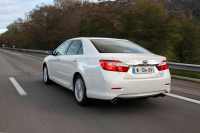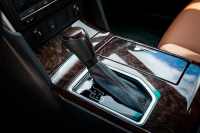Toyota Camry is the most desirable car on the secondary market. Camry became widely popular with the release of the 30-series, and Camry XV40 was just a bestseller. But the main hero of the article is the Camry XV50 with mileage. Next, we will consider all the nuances concerning the exterior and technical condition, what problems may await, and what is good business sedan today?
About the body.
Remarkably, the Camry of the 21st century has ceased to amaze with its excellent corrosion resistance. Thus, the "thirty" holds up well to this day, but it costs a lot of effort and attention, and the XV40 already in the early years showed all the weaknesses. Our hero has only gotten worse in this regard. On a used car you will with 99% probability find rust spots or underpainting in these places, a lot of bugs and chips on paintwork. There are a lot of places vulnerable to corrosion: the door flap, trunk lid and opening, as well as the floor, wheel arches, body welds and suspension parts, including subframes. The bugs on the edge of hood and windshield, due to age, are not critical yet.
You should not be surprised with different thickness gauge readings, while checking a body. Although the Camry is a reliable car, it is as cheapened as possible regarding the paintwork and quality of materials for interior and exterior trim. In addition, it is the most popular car in its class, its owners are mainly young people, which means the probability to take part in accidents of different severity is rather high.
Flaking of paint on side members is not always the sign that the car was in an accident, it is a feature of the model. I strongly recommend you to examine thoroughly the underbody, which can be both perfect and full of corrosion, besides it is "protected" by plastic. Wheel arches are covered with felt locker, from which there is more trouble than good - it absorbs water, provoking the formation of rust.
Wheel arches are covered with felt locker, from which there is more trouble than good - it absorbs water, provoking the formation of rust.
Carefully examine the right sill and front passenger's floor, because the VIN of the car is there, and the duplicating plate on the middle strut on the driver's side.
By the way, the thickness of paint on white Camry barely reaches 100 microns, so think before you stop on this choice.
A few words about the trim: the bumpers are quite strong, the brackets do not sag, by 50,000 km can fail door limiters.
Interior.
The interior of the Camry XV50 is quite spacious and comfortable and well "readable" to determine the exact mileage. All because the steering wheel trim quickly wears out, as well as all sorts of keys, the sill pads get worn out, the sides of the seats get worn out. Such indicators obviously indicate the run of 200+ thousand km.
 Extraneous crickets and rattle of plastics is also a sign of run over 100,000 km, or an evidence of additional noise isolation, which is often made on Camry due to its total absence.
Extraneous crickets and rattle of plastics is also a sign of run over 100,000 km, or an evidence of additional noise isolation, which is often made on Camry due to its total absence.
The interior is designed for careful users, for frequent breakage of glove compartment cover, cupholder cover on the center console, breakage of seat heating wires.
About electrics and electronics
Electric equipment of Camry has never been complex and sophisticated. The row motors have problems with overrunning clutch of the generator and the need to change the drive belt more often. By 300,000 kilometers, you should pay attention to the door wiring harnesses, the engine cooling fans are noisier, and poor sealing of the headlights and fog lights will require attention by 5 years of operation.
About brakes, suspension and steering
There are no questions to the resource and reliability of the brake system, but for this car they are weak, so it is easy to overheat the discs, and leads them the first time. This defect is noticeable on the original brake "pancakes", after installing analogs (Brembo, TRW, Remsa) the problem disappears. Pads last for a short time, and with a 3.5 engine for barely 30,000 km. It is better to treat rear brake pipes beforehand with an anticorrector.
 The suspension is an example of reliability and comfort. Even with rigid operation many components are still original by 200,000 kilometers. The only point is in the struts and bushings of stabilizer - these parts became common expendables long ago.
The suspension is an example of reliability and comfort. Even with rigid operation many components are still original by 200,000 kilometers. The only point is in the struts and bushings of stabilizer - these parts became common expendables long ago.
Hubs also serve 200-250 km under the condition of standard dimension disks and tires.
The big disadvantage of suspension is corrosion. Subframes corrode actively, camber bolts get stuck.
The power steering rack with electric booster is also reliable, but it has little information. If you can feel a knock of the rack - it is enough to replace cheap fluoroplastic bushings and add grease, which they obviously spared at the plant.
About the transmission
The Camry 50 has only front-wheel drive and only an automatic transmission. Half-axles here do not suffer from corrosion, and CV joints last for 300,000 km. Before the restyling with 2.0 engine it had U241 4-speed automatic transmission, and after the restyling and with 2.5 and 3.5 engines - U660/U760. A few words can be said about the old automatic transmission Aisin U241: it is "ancient" and incredibly reliable, perfectly digests torque up to 2 liters, but "thoughtful" and not frugal. The basic Aisin U660E/U760E/U761E transmissions are certainly not "eternal" any more, but in the class of six-speed automatic transmissions they are one of the most reliable. Like all modern Aisin automatic transmissions, they don't tolerate dirty oil, the GTE pads tend to wear out quickly, and the hub bushing can be welded to the hub when vibration occurs. There are two reasons for all the problems with automatic transmissions: untimely oil changes and overheating.
 On the mechanical part of the automatic transmission not all is well either: the output shaft bearing is prone to overheating, after which the locking ring loosens and the bearing turns, damaging the front cover. A new bearing costs about 4,000 rubles, the same amount as a new sun gear, but a new cover is about 70,000 rubles, but it can be restored three times cheaper.
On the mechanical part of the automatic transmission not all is well either: the output shaft bearing is prone to overheating, after which the locking ring loosens and the bearing turns, damaging the front cover. A new bearing costs about 4,000 rubles, the same amount as a new sun gear, but a new cover is about 70,000 rubles, but it can be restored three times cheaper.
Powertrain
Under the hood of the base version was installed outdated and seen two previous generations of Camry - 1AZ-FE, 2-liter with 148 horsepower. After the restyling, a 2.5 liter 2AR-FE was installed under the hood, and of course the famous 3.5 V6 2GR-FE with 249 and 277 horsepower (with upgraded cooling system, intake and exhaust). The less popular post-Restyle 2-liter direct-injection 6AR-FSE motor was also added.
Despite legendary reliability, the 1AZ-FE has issues with weak threads under the cylinder head bolts, and there were no repair pistons. Now masters freely set liners under the new cylinder head bolts, the repair size pistons 2, there is a repair liners, and everything else that will operate the car with such a motor any one hundred thousand km.
 Resource of the chain and piston on the 2.0 about 250,000 km, but the cost of the contract motor, incomparable with the cost of an overhaul, so it is not surprising if under the hood of the Camry 50 is "contract".
Resource of the chain and piston on the 2.0 about 250,000 km, but the cost of the contract motor, incomparable with the cost of an overhaul, so it is not surprising if under the hood of the Camry 50 is "contract".
2AR-FE is not much different from 1AZ in design: the cylinders volume was increased, oil pump was moved to the front cover, phasor regulator was added and EGR was removed. By the way, the engine has balancer shafts, which are driven by plastic gears, that is why one can not use too aggressive anticlocking, so as not to damage teeth.
As for the 2GR-FE, this V-twin is extremely hard to break. The power is enough by eye, the fuel consumption is moderate, the main thing is to monitor the serviceability of the cooling system, because the engine works in a tight under-hood space. With careful handling the engine is able to serve 400,000 km.
To summarize.
Is it worth buying a Toyota Camry 50 today? The price on the secondary market is extremely overpriced, and if you consider that in a short time will have to spend for full or partial restoration of paintwork, to protect the body with corrosion treatment, in the end the cost of the car will be comparable to the new generation in the body XV70.
Technically, the Camry holds the level of a really reliable car. This is a decent car, and will please you for a long time, provided that originally you will not buy a "killed" instance.


-rear-and-front-view-camera-6.png)

